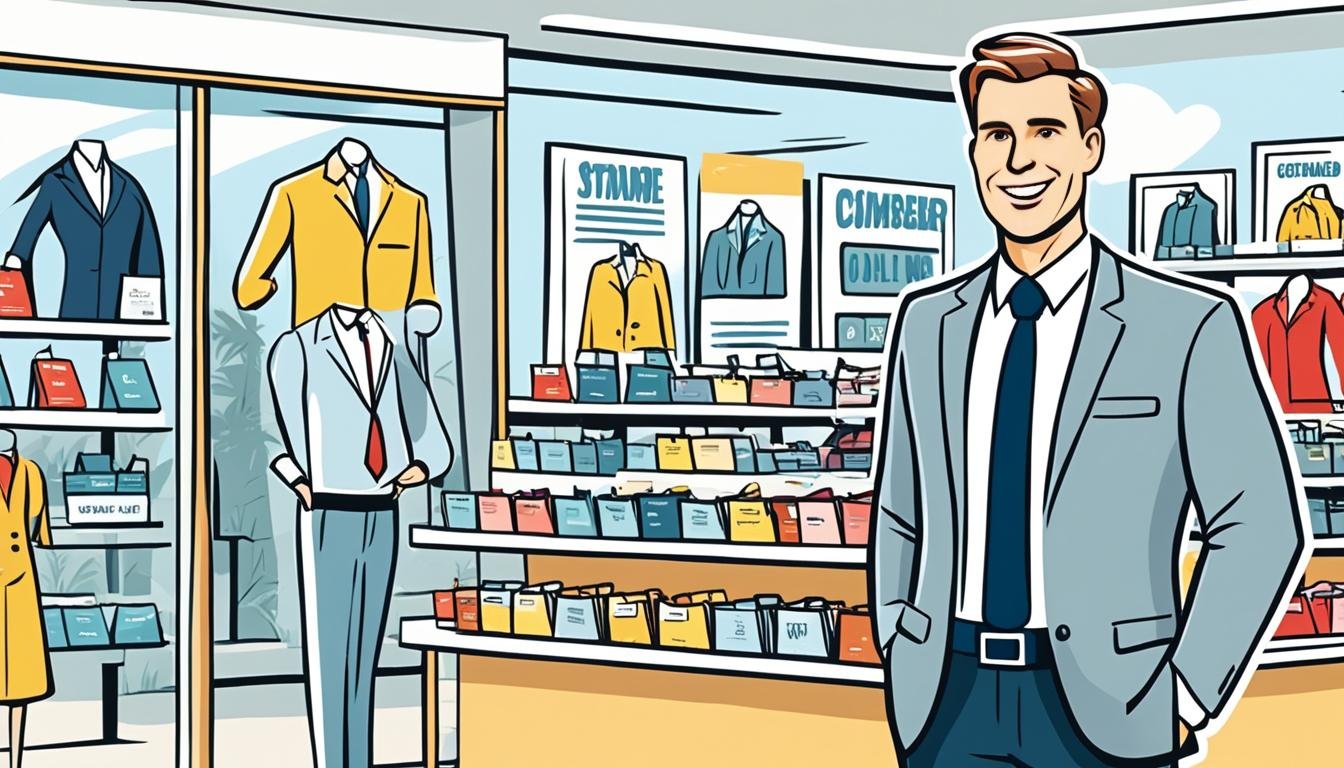Leadership in Retail: Creating Customer Experiences
“The greatest leader is not necessarily the one who does the greatest things. He is the one that gets the people to do the greatest things.”
– Ronald Reagan
The retail industry is always changing. The COVID-19 pandemic made this even more clear. Now, we need new and customer-focused ideas. In this changing world, great leaders are essential. They help create amazing experiences for customers, which leads to success.
Stores that put their customers first and have strong leaders do well. They are ready to face any new trends in the market. They also stand out from the competition. By keeping the focus on customers and using all available channels, these stores make strong connections. They also improve their image and increase their sales.
Key Takeaways:
- Effective leadership is the key to creating exceptional customer experiences in the retail industry.
- Prioritizing customer-centric strategies and developing strong retail leadership skills are crucial for success.
- Omnichannel customer experience approaches are essential to meet evolving consumer expectations.
- Retailers should focus on building lasting relationships and enhancing brand reputation through customer experience excellence.
- Customer journey mapping and retail management strategies play a vital role in delivering exceptional customer experiences.
The Importance of Customer Experience in Retail
Customer experience is key for any retail store’s success. *Positive experiences* make customers want to come back. They spend more and tell their friends about the store. In a busy market, standing out by providing great experiences is crucial.
To make customers happy, understand their journey. Look at every step they take with the brand. This could be browsing online or talking to staff. Make sure every moment is good.
Creating Emotional Connections
Feelings like joy and trust really matter in retail. Make customers feel good all along their journey. This builds trust and keeps them coming back. It also makes your brand shine in their eyes.
“A customer’s emotional experience has a major impact on their decision to continue doing business with a brand. By creating positive emotions at every customer touchpoint, retailers can strengthen their customer relationships and foster brand loyalty.” – Jane Smith, Retail Expert
Enhancing Brand Reputation
Having a good brand image is vital. Great customer experiences help build it. When customers love your store, they tell others. This spreads good words about your brand.
Good reviews and recommendations bring new customers. But bad ones can hurt you. They might stop others from trying your brand.
Building Trust and Loyalty
Trust is the bedrock of strong customer relationships. Keep giving great experiences. This makes customers believe in your brand. They’ll feel sure you’ll always meet their needs.
Loyalty programs and special treatments help too. They show you care about your customers as individuals. This keeps them coming back. They’ll choose you over others.
About the Author
Jane Smith knows a lot about retail. She’s been in the business for more than 15 years. Her work focuses on making customers love brands more. She often speaks at events and writes about managing retail well.
| Benefits of Exceptional Customer Experience in Retail | Examples |
|---|---|
| Increase in customer loyalty | Customers repeatedly choosing a particular retailer over competitors for their shopping needs |
| Higher spending | Customers making larger purchases or more frequent purchases due to their positive experiences |
| Positive word-of-mouth marketing | Customers recommending a retailer to friends, family, and colleagues based on their great experiences |
| Enhanced brand reputation | A retailer being known for providing outstanding customer experiences and having a positive reputation among consumers |
The Retail Customer Experience Definition
The retail customer experience is all about how we feel and think when we interact with stores. It’s not just about buying things. It includes the feelings, thoughts, and whether we are happy with the brand we’ve chosen.
Every interaction with a brand, whether in the store, online, or by talking to customer service, affects what we think of the brand. It also plays a part in what we decide to buy. So, it’s about the emotions and thoughts we have about the brand, the service we get, and how satisfied we are.
A good retail experience benefits the store in many ways. Happy customers spend more and tell their friends good things about the brand. This word-of-mouth can really help a store stand out. It helps the store keep its customers happy and loyal.
“The retail customer experience is the bridge between a brand and its customers, connecting them through emotional engagement and lasting impressions.”
– Retail Expert
Touchpoints in the Retail Customer Experience
Touchpoints are everywhere a customer interacts with a brand. This includes stores, apps, websites, and more. At each point, the brand has a chance to make a good impression.
It’s important for brands to manage these points well. This ensures that the experience feels the same no matter where the customer is interacting with the brand. A consistent experience builds trust and makes customers happy.
The Emotional and Cognitive Result
How we feel and what we think about a brand really impacts our choices. Emotions, like how a brand makes us feel good, are key. They make us want to come back and tell others about the brand.
Thinking also plays a big part in our experience. This is about what we believe the brand offers, how easy it is to find what we need, and how well the brand talks to us.
The whole shopping experience is a mix of these emotions, thoughts, and how well we think the brand meets our needs. Brands should work to make each interaction positive, to match what customers expect and keep them coming back.
Improving the Digital Retail Experience
In today’s digital age, a smooth online shopping experience is key for retailers. They can enhance it by focusing on certain strategies. This drives satisfaction. Here are some key points to consider:
User-Friendly Website
A user-friendly website is vital for a good online shopping experience. Retailers need to focus on easy navigation and clear product groups. They should also ensure customers can search easily. A well-organized layout helps customers quickly find what they need.
Personalization
Personalization improves the digital shopping experience. It uses customer insights and data analytics to offer personalized suggestions and content. This approach boosts engagement and fosters strong customer relationships.
Responsive Customer Support
Responsive customer support is essential online. Retailers should provide support via live chat, email, and phone. They must also respond quickly and helpfully. Addressing customer questions promptly builds trust and loyalty.
Mobile Optimization
Mobile optimization is a must in our mobile-driven world. A site that adjusts well to mobile devices is key. Retailers should focus on designs that are mobile-friendly, load fast, and are easy to navigate.
Secure and Transparent Transactions
To build trust, online transactions must be secure and transparent. Retailers need to use strong security measures. They should also clearly communicate transaction details, including shipping costs and return policies. This makes the shopping process clearer and less frustrating for customers.
By using these strategies, retailers can make digital shopping better. This leads to happier customers and long-term success.
Enhancing the In-Store Retail Customer Experience
To make the in-store experience stand out, retailers must focus on many areas. They need a great store layout and design. They also need well-trained staff, exciting events, and a quick checkout. Plus, having customer feedback stations can help a lot.
Store layout and design are key for a great shopping vibe. A store that feels welcoming and easy to move around in helps customers. When stores use clear signs and organize products well, shopping becomes fun and effortless.
Staff training is crucial for top-notch customer service. Knowledgeable and friendly staff can guide customers, offer advice, and create a welcoming feel. It’s not just about knowing what’s for sale. Good customer service includes understanding how to interact with people and solve problems.
In-store events and promotions make shopping more interesting. From a new product launch to a discount sale, these special events make the store exciting. They can draw in customers and show off what the store has to offer.
An efficient checkout process is vital to keep customers happy. Quick and easy payments make a big difference. Technologies like self-checkout and mobile pay are great. Staff members should also be quick to help out at the checkout.
| Benefits of an Efficient Checkout Process | Customer Feedback Stations |
|---|---|
| Reduces customer frustration | Provides customers with a platform to voice their opinions |
| Speeds up the overall shopping process | Collects valuable insights for improving the retail experience |
| Enhances customer satisfaction | Allows retailers to address and resolve issues promptly |
Customer feedback stations are a smart way to hear from customers directly. Placed around the store, they let customers share what they think. Retailers can use this feedback to adjust and meet customer needs better.
By working on store layout, staff training, events, checkout speed, and feedback, retailers can make their store a place customers love. This approach builds loyalty and satisfaction.
Measuring Customer Experience in Retail
Retailers measure customer experience to see if their strategies work. They often use three main metrics. These are Net Promoter Score (NPS), Customer Satisfaction (CSAT) Score, and Customer Effort Score (CES). These help them understand their customers better and make their stores or services even better.
Net Promoter Score (NPS)
Net Promoter Score (NPS) shows how loyal customers are to a brand. It asks a simple question: “On a scale of 0-10, how likely are you to recommend our brand to others?” Customers are then put into three groups: promoters (9-10), passives (7-8), and detractors (0-6). Subtracting the detractors’ percentage from the promoters’ gives the NPS. A higher NPS means more customer loyalty.
Customer Satisfaction (CSAT) Score
Customer Satisfaction (CSAT) Score shows how satisfied customers are with a brand. Retailers ask for feedback through surveys to figure this out. The CSAT Score is calculated by the percentage of satisfied customers. This number helps retailers know if their customers are happy or not.
“We truly value our customers’ voices. Their satisfaction is paramount in our quest to provide exceptional experiences and exceed their expectations.”
Customer Effort Score (CES)
Customer Effort Score (CES) measures how easy it is for customers to solve issues or get things done. It looks at how much effort a customer has to make. Knowing the CES helps retailers find and fix what’s hard for their customers. This makes the shopping experience better.
NPS, CSAT Score, and CES give retailers important information about customers. This data helps them know what to improve. With these metrics, retailers can always work to make their customers happier. Happy customers mean more business success.
Importance of Retail Customer Experience for Revenue Growth
Good experiences at stores are crucial for making more money. When people enjoy shopping at a store, they’re likely to spend more. They also come back to buy more often. This boosts a store’s income.
Stores that put customers first stand out from the crowd. They focus on making every interaction special. This approach helps them beat their competitors. Happy customers tell others about their good experiences. This brings in even more business.
When stores are fun to shop at, customers get more involved. They give feedback, join loyalty programs, and even help promote the brand. This makes them closer to the store and more likely to keep shopping there.
“Customer experience is the key driver of revenue growth in the retail industry. Satisfied customers are not just more likely to spend more, but they also become loyal advocates who bring in new customers through positive recommendations.”
By creating enjoyable shopping experiences, stores can make customers into fans. These fans not only come back but also tell others about the store. This builds trust and loyalty.
In today’s world, standing out in retail is hard. That’s why focusing on the customer is so important. It’s the way to keep growing your business. With good customer service, stores can keep people coming back.
Retail Customer Experience and Competitive Edge
Great customer experiences help stores outshine their rivals. Being remembered for a cheerful shopping experience makes a brand stand out. Shoppers often pick brands that not only offer top products but also make them feel good.
Stores become distinctive by focusing on what customers want. They tailor their stock to make shopping special. Such efforts turn buying into a cherished adventure.
Creating personal connections is also key for success. By using data, stores recommend items just for you. Feeling like you matter makes shopping more enjoyable.
But it’s not just about being personal. Stores need to feel welcoming too. This means easy-to-get-through layouts, pretty displays, and helpful staff. A warm store memory makes a brand hard to forget.
Technology is another tool for better shopping. Websites and apps should be both simple and fun to use. Virtual try-ons and AR make picking products more exciting. These advances offer a fresh way to shop.
At the end of the day, customer experiences are the real game-changer in retail. By standing out with top-quality items and personal, fun shopping, stores win over customers. Investing in such experiences pays off in happy shoppers and a strong business.
Word-of-Mouth Marketing and Retail Customer Experience
Satisfied customers often become brand ambassadors. They share their good experiences with others. This kind of promotion is very important for getting new customers.
Retailers who make sure every customer has an excellent experience get more good reviews. They also keep their customers coming back.
Great customer experiences are key to spreading the good word. When people like a store or a brand, they talk about it. Their friends and family often listen to these recommendations, which can lead them to also choose that brand.
When a brand makes people happy, they keep coming back. They also tell others about it. This is like free advertising, but it’s more powerful because it’s based on someone’s real experience.
Having loyal customers means having people who really support your brand. They go out of their way to tell others about it. This makes more people interested and increases your customer base over time.
Customer Testimonial:
“The exceptional customer service and personalized shopping experience at XYZ Retail made me a loyal customer. I couldn’t help but share my positive experience with all my friends and family. I highly recommend visiting their store!” – Sarah
Strategies for Improving Retail Customer Experience
Building great customer experiences is crucial for success in retail. Retailers should consider both in-store and online experiences. Here are some strategies to boost customer satisfaction and loyalty:
1. Enhancing User-Friendliness
Make websites and apps easy to use. Navigation should be clear, and the site should be easy to browse. Allow customers to find, compare, and buy products without confusion.
2. Personalization
Make online shopping more personal by using customer data. Use analytics to suggest products, offer personalized deals, and send targeted ads. This personal approach boosts customer happiness.
3. Optimizing the Checkout Process
Make the checkout quick and easy. Reduce the steps to buy something and offer a guest checkout. Also, give several safe ways to pay. This makes shopping more pleasant and reduces cart abandonment.
4. Creating Inviting Store Layouts
Design stores that look good and are easy to navigate. Make sure there’s enough space, the displays are clear, and signs are easy to follow. This leads to better in-store shopping and more sales.
5. Investing in Staff Training
Train your staff well to provide great service. They should know how to talk to customers, have good product info, and handle issues well. A well-trained team improves the customer’s visit and loyalty.
6. Organizing In-Store Events
Hold events in your store to make shopping special. These could be launches, classes, demos, or sales. Events create buzz, bring in more people, and let customers connect with your brand.
7. Actively Seeking Customer Feedback
Put up feedback stations in your store and online. Ask customers to share their thoughts. Always use their feedback to make the experience better. This shows customers you care about what they think.
By using these strategies, retailers can make the customer experience better and stay ahead in the competitive retail world.

Measuring and Improving Retail Customer Experience
Measuring customer experience helps retailers understand satisfaction and loyalty. They use metrics like the Net Promoter Score (NPS), Customer Satisfaction (CSAT) Score, and Customer Effort Score (CES) to see how they’re doing. This way, they can find ways to get better.
The NPS shows how likely customers are to recommend the brand. A high NPS means happy customers who may tell others about the brand.
CSAT measures how satisfied customers are with their experiences. It helps retailers know what they’re doing right and where they need to improve.
CES looks at how easy it is for customers to solve problems with the brand. A low CES means customers find it easy to deal with the brand, which is good.
Retailers can use data and predictive analytics to keep making the customer experience better. They should look at data from their website, social media, and customer service to understand what customers like and don’t like.
Predictive analytics lets retailers guess what customers might want. By looking at past data and using models, they can plan better strategies for the future.
Improving customer experience can lead to more success and happy customers. By using key metrics, data, and predictive analytics, retailers can change for the better. They can offer amazing experiences to their customers.
Conclusion
The COVID-19 pandemic shook up the retail world. It changed how people shop and how businesses serve them. Now, being a strong leader in retail is key. Focus on making your customers’ experiences top-notch, both online and in stores. This is how you’ll stand out and make more money.
To do well in retail, focus on great experiences. Improve your online and in-store shops. Make your websites easy to use. Show customers things they like. Make paying easy. And, train your staff to be super friendly. This makes customers happy and keeps them coming back.
Good leadership is essential in these uncertain times. Leaders who value customer experience do better. They encourage new ideas and keep making their shops better. This is how they lead their stores to success.
FAQ
What does customer experience mean in the retail industry?
Customer experience in retail is about how people feel and think after they interact with a brand. This interaction includes all points of contact, not just buying things. It covers emotions, what people think, and how satisfied they are.
How can retailers improve the digital retail experience?
To make digital shopping better, retailers should have a website that’s easy to use. This means clear menus and an easy way to pay. They should also make the site feel personal by using data to understand what customers want. Offering helpful support, making the website work well on phones, and ensuring transactions are safe help too.
How can retailers enhance the in-store retail customer experience?
Making in-store shopping great involves a few strategies. Retailers need to design their stores in a way that’s welcoming and easy to get around. Staff should be well-trained to offer top-notch service. Having events and promotions in the store, making paying easy, and asking for feedback all make a difference. It all adds up to a better shopping experience and happier customers.
What metrics can retailers use to measure customer experience?
There are a few key numbers to watch to see if customers are happy. Net Promoter Score tells you about customer loyalty. Customer Satisfaction Score and Customer Effort Score show how satisfied people are and how easy it is to shop. These scores help retailers understand what customers need and how to get better.
How does retail customer experience impact revenue growth?
Good customer experiences make people spend more and come back to shop again. Happy customers are more likely to splurge and tell their friends. This way, retailers who care about their customers do better in the market and get more shoppers through friendly recommendations.
How does retail customer experience give a competitive edge?
The best way for retailers to stand out is by making customers remember how great it feels to shop with them. Even with good prices and products, what sets a brand apart is the shopping experience it offers. When customers have a good time and like what they buy, they are likely to pick that brand again.
How does word-of-mouth marketing play a role in retail customer experience?
Happy customers talk about their good times shopping more than any advertisement can. This way of spreading the word helps bring in new shoppers. Retailers that consistently make their customers happy benefit from this, seeing more people come back and choose them again.
What are the strategies for improving retail customer experience?
Retailers should work on both their online and in-person stores to keep customers happy. This means making websites and apps easier to use, giving a personal touch to online shopping, and making sure paying is a breeze. In the physical stores, shops should be laid out well, staff should be ready to help, and there should be fun events. It’s also vital to listen to what customers say and act on their feedback. Doing all this boosts how satisfied people are and how much they trust the brand.
How can retailers measure and improve customer experience?
To know if customers are happy, retailers can look at NPS, CSAT, and CES scores. These tell how satisfied and loyal customers are. By using these numbers and studying operations, retailers can find ways to make the shopping experience even better. Better customer experiences lead to lasting success and happier shoppers.








